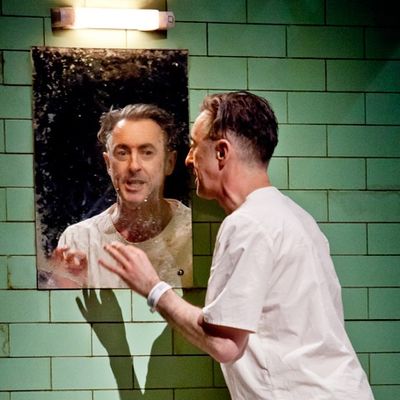
Had Macbeth premiered in, say, 2011 instead of 400 years earlier, Shakespeare’s handlers might have needed to book him on a mea culpa tour, culminating with Oprah, to apologize for his unseemly blurring of fact and fiction. It’s true that the real Macbeth, who reigned in Scotland starting around 1040, killed his predecessor, King Duncan. But almost everything else in the play is conflation, elaboration, invention, and blarney.
The text itself may be just as corrupt. Based on its extreme brevity—it is by far the shortest of Shakespeare’s tragedies—some scholars think that the version we know is actually a condensation of the original, possibly based on a prompt book. The upside is that it’s a quick read with nonstop action: perfect for high-school English. The downside is that the sense of emotional motivation is thin, the characters being mostly underdeveloped. For all the beautiful poetry, I usually feel after seeing it like Lady Macbeth, washing the damned spots off. It’s a bloody chore.
Not so the wicked smart National Theatre of Scotland production starring Alan Cumming as him, her, and (almost) everyone. In adapting the arguably overexposed work, Cumming and the co-directors John Tiffany and Andrew Goldberg have taken to heart Lady Macbeth’s admonition: “To beguile the time, look like the time.” In context, she is telling her husband to plaster a smile on his face if he wants to avoid arousing suspicion over his quasi-Oedipal butchery. But the advice works for the storytellers too. To get around the tale’s deadening familiarity, make it new and make it now.
So this Macbeth takes place in the greenish locked ward of a psychiatric hospital. (A cliché, perhaps, but not as much of one as the abattoir in which Broadway’s previous Macbeth, starring Patrick Stewart, was set.) In a wordless prologue Cumming is led into the large, sterile room by a doctor and an orderly. As he removes his street clothes, we see long bloody scratches across his upper chest. The doctor and orderly take buccal swabs and fingernail samples and offer him a pair of pajamas and slippers. It’s all very gentle and respectful; they have, it would seem, all the time in the world. But the hinge moment is arriving. As the medical duo leaves, Cumming asks them, imploringly, “When shall we three meet again?”—thus neatly introducing the Macbeth portion of the program with the play’s first line.
The story then unfolds even more swiftly than usual. (Thanks to extensive cuts, the whole thing takes just 100 minutes, without an intermission.) No sooner has Cumming’s compunctious Macbeth heard the witches’ prophecy than he transforms into his own grasping wife with the addition of a ward blanket. Then he’s both in argument, switching body position and voice just enough to make it clear. This is thrilling; still, as the tale progresses, the need to distinguish so many roles from one another fosters some caricature. Ross is a bit of a dim jock, King Duncan halfway to Paul Lynde. But the constraint also fosters a great deal of invention. The witches are rendered as three different closed-circuit images of Cumming, displayed on screens above the stage. Banquo’s ghost is indicated subtly and brilliantly—I won’t say how, but it produced, in me at least, the thump of dread you want in Macbeth and seldom get.
The economy and cleverness of the staging is no less than you might expect from Tiffany especially, whose direction in both downtown and uptown modes (Black Watch at St. Ann’s; Once on Broadway) displays an uncommon facility with big but delicate gestures. Every element of the design—set, sound, costume, video, lighting—is ideally tailored to the concept. And Cumming is more disciplined than you might imagine; his delicious sense of camp is confined to the appropriate characterizations, and his voice for verse, with those big Scots vowels, is outstanding. He’s tireless and brave in enacting a difficult story.
But whose story is it? With so much of the plot whacked away, the version of Macbeth presented here emerges as almost the opposite of its source, like a field-and-ground illusion. The violence, necessarily, is all self-inflicted. The pageantry is reduced to the occasional arrival of the hospital staff (played with dignity by Jenny Sterlin and Brendan Titley) to administer medication or clean up the mess. The emphasis on the greatest-hits poetry, and on those elements of the Shakespeare that deal with the anguish of fathers and sons—the sons here played by an eerie doll—turn this most action-oriented play into something preeminently psychological. Of course this is abetted by the setting, which includes an observation window in which we frequently see the staff worrying over their patient’s odd behavior. He sobs, he runs in circles, he bleeds. His mind, like Macbeth’s, is “full of scorpions.”
Clearly, Cumming’s character in the outer story has been institutionalized after a violent episode of some kind; his obsessive relation of the Shakespearean tale must reflect on his own madness. There are plenty of clues as to what the source of that madness might be: the scratches, the doll, a sweater in a bag that’s even marked EVIDENCE. As you weigh these, and perhaps come to some tentative conclusions, you realize that you have gradually been forced not further into Macbeth but into its frame, even if you don’t quite know what it is. It’s an odd and possibly Oedipal irony that the invented story is as thin and underdeveloped as the one it nearly obliterates.
Macbeth is at the Ethel Barrymore Theatre through June 30.

